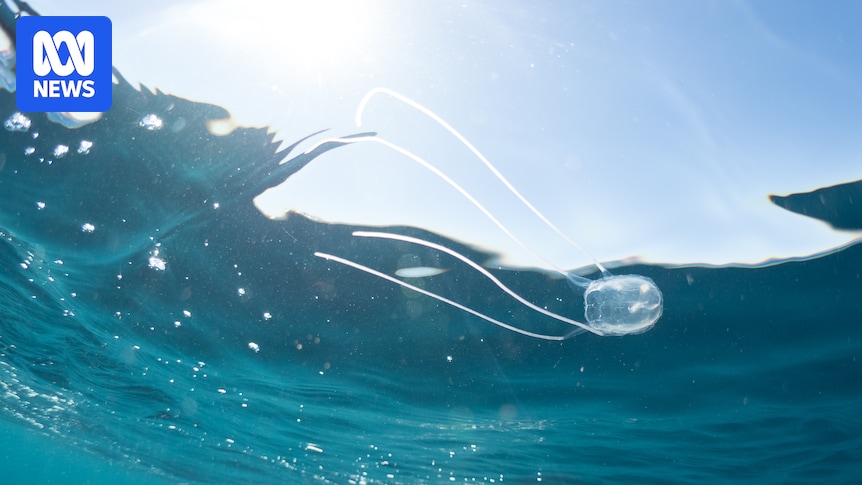They may be tiny, but Irukandji jellyfish can pack a fatal punch.
Residents in Western Australia’s far north know to be wary of jellyfish stings, especially during the wet season from November to April.
But an “unusual” sting at Broome’s tourist hot spot Cable Beach in late July has sparked the interest of overseas academics at the University of Hawaii, who will do further research into the species.
WA Country Health Service would not release information on the latest patient’s condition.
While incidents of Irukandji stings are rare, they can be life-threatening and cause other side effects like feeling an impending sense of doom.
A swimmer was stung by an Irukandji jellyfish at Cable Beach in July. (ABC Kimberley: Ruby Littler)
The local shire website warns Irukandji jellyfish are typically present during the wet season, but former CSIRO marine biologist and jellyfish expert, Lisa-ann Gershwin, said they frequented Broome waters year-round.
“There are actually no months of the year where we haven’t had stings, so there isn’t a ‘safe season,'” she said.
“There is a kind of safer season where they are less common … but there’s always a chance.”
What happens after a sting?
When a swimmer is stung at Cable Beach, lifeguards close the beach to swimming and conduct stinger drags, which involves sampling sections of water close to the shore for the presence of jellyfish.
Lifeguards identify the jellyfish, and if needed, researchers conduct further studies.
A small plastic jar containing Irukandji jellyfish preserved in formaldehyde. (ABC Far North: Mark Rigby)
But lifeguards don’t only conduct stinger drags when an incident occurs.
It’s a routine precautionary measure done twice daily to ensure safety, according to Shire of Broome manager of environmental health, emergency and rangers Aaron Ahtong.
Lifeguards regularly conduct stinger drags at Cable Beach. (ABC Kimberley: Ruby Littler)
“The lifeguards are constantly monitoring conditions,” he said.
“So, including the drone patrols, they are doing everything they can to make sure the community is protected.”
How frequently do stings occur?
While the Irukandji species is not rare in tropical environments, being stung is uncommon.
Mr Ahtong said there were six recorded stings in the past five years.
This marks a significant decrease from the findings detailed in the Medical Journal of Australia, Irukandji syndrome in northern Western Australia: an emerging health problem, 20 years ago.
James Cook University researchers breed Irukandji jellyfish in captivity. (ABC News: Sharnie Kim)
The report found 88 people were treated for Irukandji syndrome in Broome between 2001 and 2003.
“[Stings] are out of the ordinary, but definitely not rare,” Mr Ahtong said.
What do we know about Irukandji?
There are 16 known species of Irukandji globally.
Dr Gershwin has named and classified 14, including all six found in WA.
There are two known types in Broome, including Malo maxima and Carukia shinju.
Lisa-ann Gershwin says education and awareness about Irukandji is important. (ABC)
“The body is about the size of a thimble and it’s got four super-fine tentacles, as fine as cobwebs, and that one I named Carukia shinju,” she said.
“Of course, shinju is the Japanese word for pearl.”
Dr Gershwin said she was surprised to hear about the timing of the latest sting, but not shocked.
“They’re natural creatures, they just go where the current takes them and they breed when the conditions are right,” she said.
“They don’t read the signs and say, ‘No, no, it’s not the right season yet.'”
Dr Gershwin said a strong onshore wind or a “cracking good storm” would heighten the stinging risk, regardless of the time of year.
“The atmospheric and oceanic conditions bring them into the beaches, where tragedy occurs when they make [contact] with people,” she said.
Should I avoid swimming at Cable Beach?
Short answer — no, but it’s worth staying informed.
Local rangers and scientists agree that Cable Beach is one of the safest beaches because of the precautionary measures taken.
Rangers says Cable Beach is safe, with regular stinger drags and patrolling lifeguards. (ABC Kimberley: Ruby Littler)
Dr Gershwin echoed the Shire of Broome’s sentiment, agreeing the most important detail was that people remained aware.
“Broome has a fairly rotating community … big tourist community and all that … perhaps that sort of baseline risk [awareness] may have been lost,” she said.
“I think scaring people to say there’s always a risk is not as effective as saying, ‘There’s always a risk, but here’s what you can do about it.'”
Dr Gershwin advised beachgoers to wear protective beachwear, such as full-length lycra suits or wetsuits, and swim in patrolled areas.

